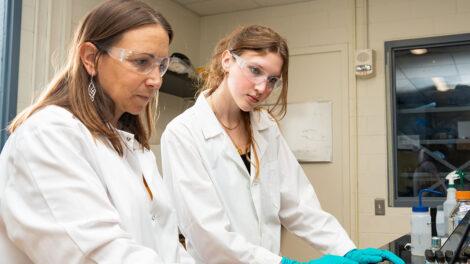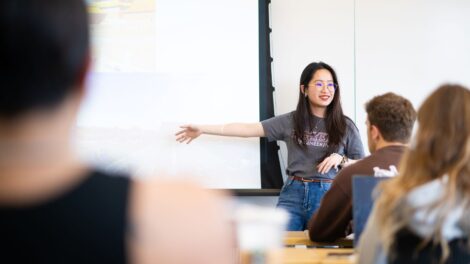Meet our new faculty: Kenzie Burns

Kenzie Burns, civil and environmental engineering | Photo by Rick Smith
My research focuses on: Cow poop!
My previous work has investigated ammonia recovery from dairy manure using bioelectrochemical systems (BES). Ammonia (NH3) is a key compound used in fertilizers and can be recovered from the abundant nitrogen in dairy manure. However, much of the nitrogen in manure is in the organic form, which requires prior mineralization to inorganic forms (like ammonia) before it can be used in fertilizer and fertilizer supplements. Bioelectrochemical systems are special types of electrochemical cells that integrate microbes to perform some of the cell processes. When these systems are operated for ammonia recovery from dairy manure, microorganisms at the anode degrade organics to produce extracellular electrons, which are sent to the cathode as current. Basically, microbes “eat” the cow poop and produce electricity from it, which is pretty cool! At the same time, microbes also perform nitrogen mineralization, converting the organic nitrogen into ammonium, the charged form of ammonia. A special membrane is placed between the anode and cathode chambers, which permits passage of positively charged ions, allowing the newly produced ammonium to transport to the catholyte and be recovered separate from the rest of the dairy manure. In this way, we’re able to get clean, concentrated ammonia from the dairy manure that can be used as a direct fertilizer supplement.
In my future work, I’d like to expand the application of BES to other high-strength organic wastes, such as cheese whey waste, brewery wastewater, and food waste. With these new feedstocks, I hope to be able to recover other valuable compounds, such as phosphates and organic acids, as well as ammonia. All of these compounds have value on the chemical market, and a resource recovery approach to high-strength waste management contributes to a more sustainable resource economy overall. I’m also interested in investigating how the organic nutrients in high-strength wastes impact the environment. For example, there is abundant research regarding the negative impacts of inorganic forms of nutrients (e.g., ammonia, nitrate, phosphate, etc.) in aquatic systems, leading to eutrophication and other harmful water quality impacts. I think it would be interesting to investigate how organic nutrients in pollution sources eventually lead to similar downstream water quality impacts, and the microbial and physicochemical transformations that naturally occur leading up to these negative impacts.
This fall, I am teaching: CE 321: Introduction to Environmental Engineering and Science. I love teaching intro courses like this, as they are often students’ first look into the field of environmental engineering. It’s very exciting to be able to serve as an early contact in the field for students, and I’m always honored to show them the ropes so early in their careers.
What students can expect from me: I would say the three biggest pillars of my teaching philosophy are collaboration, engagement, and inclusivity. I believe learning to be a highly collaborative process, so I offer abundant structured and informal group work in my courses. I also think it’s important to give students agency in the course content, so the collaboration is not just between students but also with me as the instructor. I’m always looking for student input on how I can make the course better tailored to their specific needs, as well as what content I can cover to make the course more engaging for each cohort. Lastly, I’m a firm believer that education and learning should be accessible and inclusive for everyone. I take several steps to design inclusive courses, such as allowing flexibility in assignment format and giving students opportunities to give and receive anonymous feedback (to/from me and their peers).
Getting to know me: I love to be outside! I have a particular affinity for backcountry adventures, with some of my favorite trips including hiking through remote areas of the Swiss Alps and (more locally) the Adirondack High Peaks. I also love to cycle and have competed in several triathlons. When I’m not outside, I like to spend my free time snuggling my cats and consuming copious amounts of coffee with my finacée, Christina.

